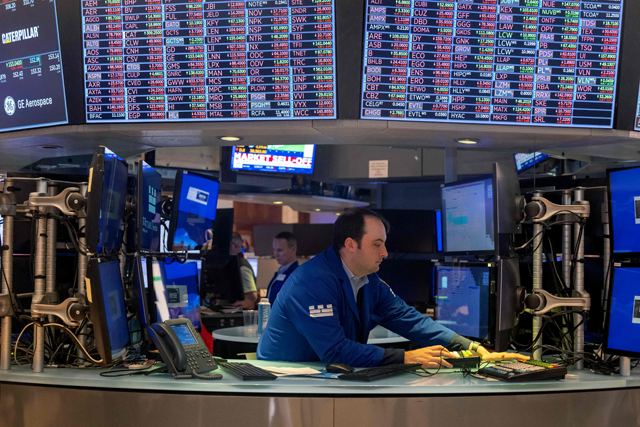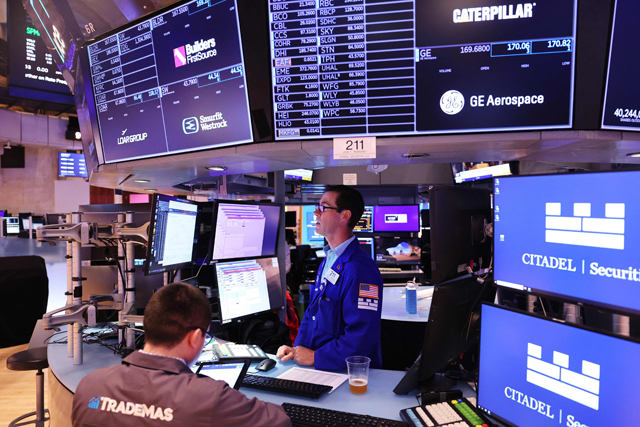You are here
What is the 'Sahm Rule' behind the market panic?
By AFP - Aug 05,2024 - Last updated at Aug 05,2024

Traders work on the floor of the New York Stock Exchange (NYSE) on Monday, in New York City (AFP photo)
PARIS — Global stock markets have been in panic mode since last week, when a weak US jobs report triggered something called "the Sahm Rule", a reliable indicator that the economy is in recession.
What is the Sahm Rule?
The indicator is named after its creator, Claudia Sahm, a former Federal Reserve and White House economist.
The rule indicates a recession has started when the three-month moving average of the US unemployment rate is 0.5 per centage points or more above its lowest during the previous 12 months.
The threshold was crossed when US government data showed on Friday that the unemployment rate had hit 4.3 per cent, its highest level since October 2021.
The Sahm Rule reading reached 0.53 points in July, according to the Federal Reserve Bank of St. Louis.
Florian Ielpo, head of macroeconomic research at investment manager Lombard Odier, said the rule was a "purely empirical" indicator with "no theoretical basis".
But the markets "have clearly drawn the conclusion that there will be a recession", he added.
Investors are worried that the US Federal Reserve has waited too long to cut interest rates, which sit at a 23-year high and were raised to tame soaring inflation.
Is the US really entering recession?
Despite the data, even Sahm herself doubts that the US economy is contracting.
"I am not concerned that, at this moment, we are in a recession," she told Fortune magazine on Friday.
"No one should be in panic mode today, though it appears some might be," she said, adding that key measures of the economy "still look really good".
Sahm pointed to growing household income along with resilient consumer spending and business investment.
"This time really could be different," Sahm said.
Research group Capital Economics said the rise in the unemployment rate has so far been driven by an expansion in the labour force rather than a fall in employment.
"This marks a difference from previous cycles," the group's chief economist, Neil Shearing, said in a note, adding that "it is likely that Hurricane Beryl contributed to weakness in July's payrolls figure."
Federal Reserve chairman Jerome Powell also sought to downplay the rule's impact.
"A statistical regularity is what I'd call it," he told a press conference following the Fed's policy meeting on Wednesday. "It's not like an economic rule where it's telling you something must happen."
Earlier that day, the Fed decided to keep its benchmark interest rate between 5.25 per cent and 5.50 per cent, but Powell signalled that a cut could come in September.
Will the Fed act sooner?
The triggering of the Sahm Rule may raise pressure on the Fed to cut rates more than expected at its September meeting — or even act beforehand.
Powell spoke two days before the latest jobs data was published.
"Obviously it is something that will worry the Fed," Ielpo said.
"Could the Fed make an unscheduled rate cut? For now, it's not likely," he added.
Some analysts now expect the Fed to cut rates by 0.50 perentage points in September, up from previous bets of a 0.25-point cut.
The Fed could make such a cut to "slow down the decline in the markets, if it really continues until then"," Ielpo said.
Deutsche Bank said markets are now pricing in a total of two per centage points of cuts over the next 12 months, "which has only really been seen before in a recession".
Capital Economics economist Shearing, however, said it saw a 0.25-percentage-point reduction at each of its three remaining meetings this year.
"While the jobs report was bad it wasn't that bad," he said
Related Articles
Washington — After pausing in June, the US Federal Reserve (Fed) is widely expected to hike interest rates again on Wednesday, adopting its
WASHINGTON — The Federal Reserve (Fed) is poised to unleash another massive interest rate increase this week after the latest data showed a
PARIS — Stock markets jumped on Friday after US Federal Reserve chief Jerome Powell made clear that the central bank was ready to cut intere


















